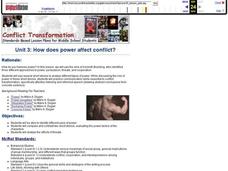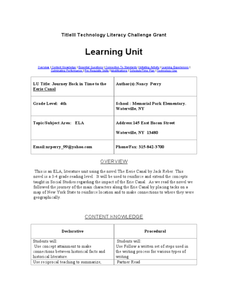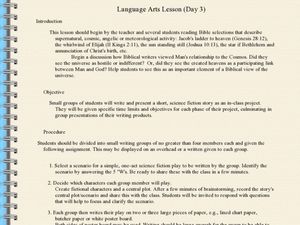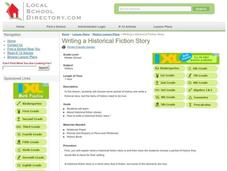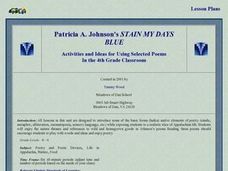Curated OER
Noisy Nora, Studious Students: Story Elements
Alliterative adjective nicknames generate stories inspired by Rosemary Wells' book Noisy Nora (also a thematic complement to any class with children who make a ruckus to get attention). Class members explore basic story elements --...
US Institute of Peace
Observing Conflict
Identifying conflict is important, but how do you handle conflict when it comes? Learners use a plot mountain to graph two role-play scenarios about interpersonal conflicts.
Curated OER
Diary of Anne Frank: Act 1 Scene 1 & 2
Eighth graders read act 1 scenes 1 & 2 of the play Diary of Anne Frank. In this Diary of Anne Frank lesson plan, 8th graders discuss how the setting of the play affects the mood of the story and answer short answer questions.
Curated OER
How Does Power Affect Conflict?
Young scholars use several short stories to analyze different types of power. While discussing the role of power in these short stories, students will practice communication skills essential to conflict transformation, specifically...
Curated OER
Rudyard Kipling's "Rikki-Tikki-Tavi": Mixing Fact and Fiction
"Rikki-Tikki-Tavi," from The Jungle Book, offers young readers a chance to examine how Rudyard Kipling uses setting and personification to bring to life the brave mongoose who battles cobras to protect his family. Class members...
Curated OER
Erie Canal: Journey Back in Time
Fourth graders read the novel, The Eric Canal, identifying the characters and setting. They respond to daily reading by writing in journals and complete a short answer test upon completion of the novel.
Curated OER
Splendid China: Chinese Folktales
Students investigate Chinese culture by reading their folk tales. In this creative writing lesson, students practice identifying the different elements in a folk tale and examine the related vocabulary. Students organize...
Curated OER
A Picture Is Worth a Thousand Words
Students, after reading the book, "Esperanza Rising," create a virtual display by combining different story elements into a visual representation. They choose the setting and characters of a scene that will act as a springboard of ideas...
National Endowment for the Humanities
Folklore in Zora Neale Hurston's Their Eyes Were Watching God
Learners define folklore, folk groups, tradition, and oral narrative. They identify traditional elements in Their Eyes Were Watching God Analyze and understand the role of traditional folkways and folk speech in the overall literary...
Curated OER
Bible Readings: Supernatural, Cosmic, Angelic, Meteorological
Students create and present a short science fiction story. For this Bible studies lesson students work in small groups and are assigned characters and a scenario to develop a play about.
Curated OER
Writing a Historical Fiction Story
What is historical fiction? After explaining the difference to your learners, it's time to give each learner a try! With your support, encourage them to research, plan, and write their own historical fiction story. Don't forget to have a...
Curated OER
Be a Vishnu Avatar
Young scholars write a story about a problem on earth. They imagine themselves as one of Vishnu's avatars or create another avatar for Vishnu who can solve the problem.
Curated OER
"Me and My Family Tree"
Students explore genealogy by reading a family history book in class. In this family tree lesson, students read the story Me and My Family Tree by Joan Sweeney and discuss their own family history. Students identify what the term...
Curated OER
Stain My Days Blue
Students read several poems related to the life and culture of the Appalachia region. They are introduced to the poetic forms of simile, alliteration and onomatopoeia and respond to the poems through journal entries and poetry of their own.
Curated OER
How Does Ancestry Affect Folklore?
Students break into groups of 4 or 5 and choose an option to demonstrate a different cultural perspective in a fairy tale or other folklore that they are familiar. Possible choices are: PowerPoint presentation, video, digital...



